

According to Greek mythology, Aphrodite, the goddess of beauty and love, was born from the foam of the sea in Cyprus, which was dedicated to her worship. Beauty, love and warmth abound even today, as the island of Cyprus enjoys exceptional sunshine and is one of the sunniest destinations in the Mediterranean.
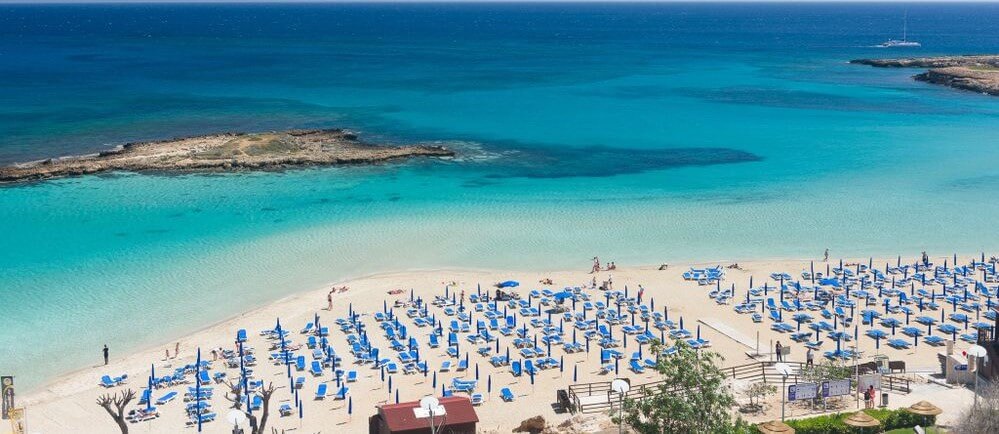
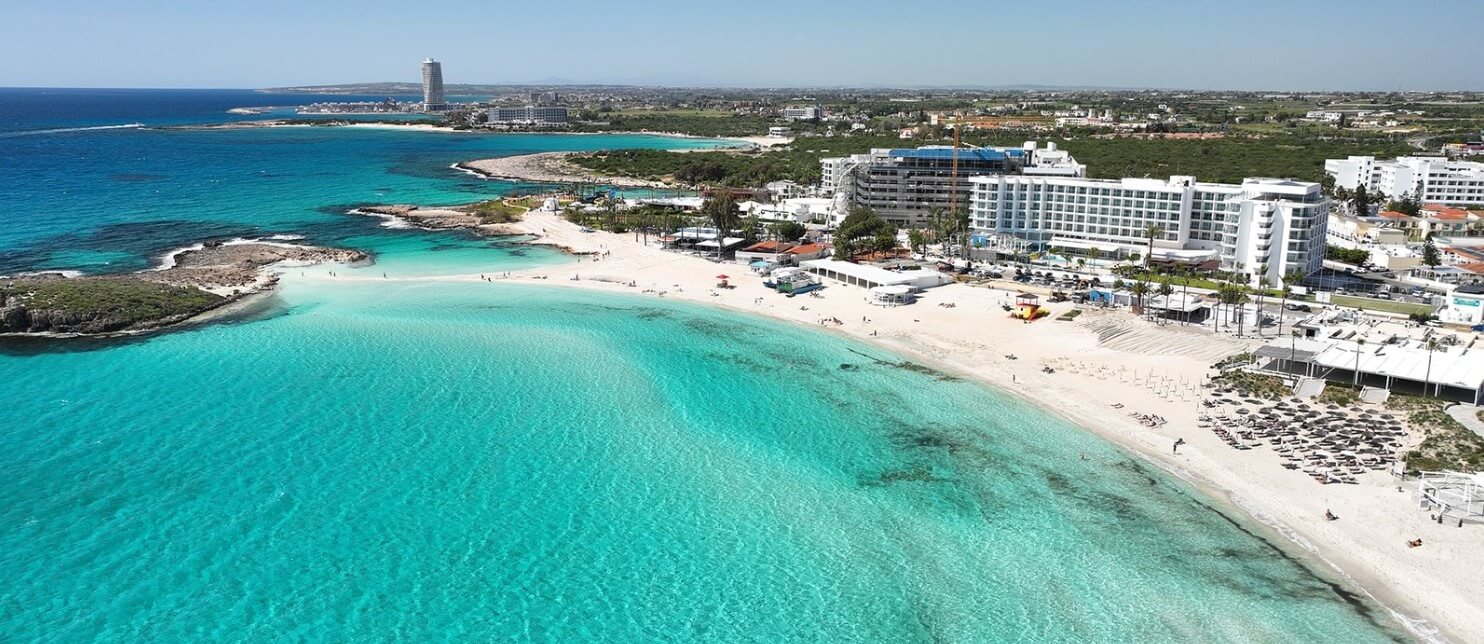
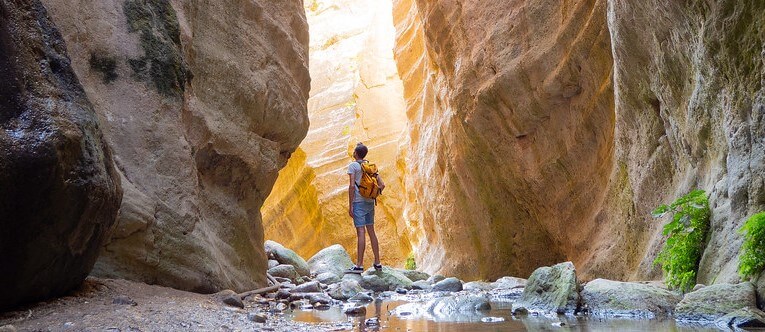
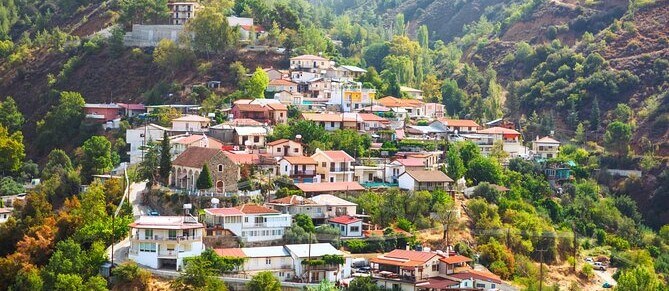
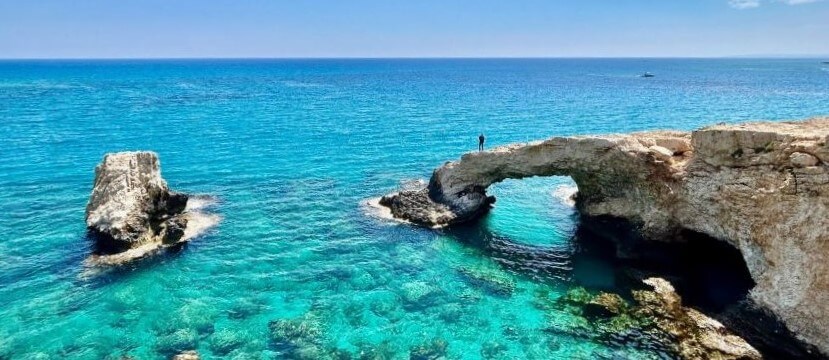
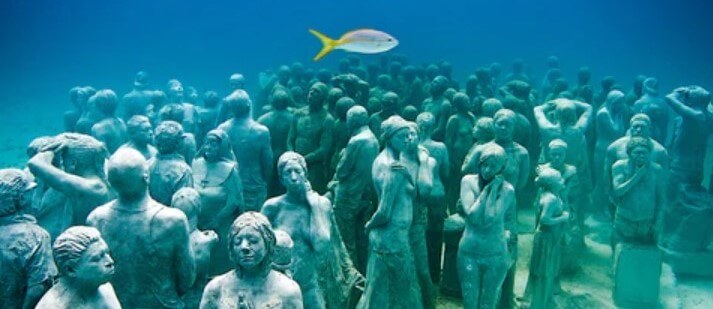
Cyprus is the third largest island in the Mediterranean after Sicily and Sardinia, and is located in the eastern Mediterranean, close to Turkey. Cyprus is divided into two regions; the southern part of the island, controlled by the Republic of Cyprus and inhabited by Greeks, and the northern part of the island, occupied by Turkey and inhabited by Turks. Most holidays are spent in the Republic of Cyprus, which covers two thirds of the island and is home to most of the island’s stunning sandy beaches. The island has a colourful history and over the millennia has been ruled by several different rulers who have left their mark on the island’s culture.
In Cyprus, the sun shines statistically more than 300 days a year. From sunbathing to diving and snorkelling, and from driving to hiking, the island offers a wide range of holidays. The island is ideal for families with children, active holidaymakers, foodies, party-goers and those interested in history and stories. Our trips are to the southern part of the island of Cyprus, the Republic of Cyprus, inhabited by Greeks. The Ayia Napa area offers a variety of turquoise beaches, services and nightlife, while the quieter Protaras area, with its gentle beaches and leisure facilities, caters for families with children and more relaxed holidaymakers.
Cyprus has three UNESCO sites: the historic town of Paphos, the ancient village of Khirokithia and the Byzantine churches of the Troodos Mountains.
Ayia Napa’s most famous attraction is the monastery square, and the buildings around it, the most famous being the monastery built in the 16th century. Ayia Napa has a maritime museum at Thala, which is attracted by an exact replica of the ancient Greek trading ship Kyrenia II, discovered off northern Cyprus in the 1980s (the original ship can be admired at Kyrenia Castle).
The church of Elias is located on a hill above Protaras, with a magnificent view of the sea.
The Troodos Mountains are home to churches on the UNESCO heritage list. The Monastery of Kykkos is also on the Troodos Mountains.
The town of Paralimni is north of Protaras and can be reached by bus, taxi and bicycle. Along the way to Paralimn there are beautiful sandy beaches and bays.
Nicosia and Larnaca are good larger shopping cities full of interesting historical sights. The city of Larnaca has a fortress, museums and the famous Lazarus Church.
From Protaras you can get close to the border of the occupied territory. The town of Famagusta is on the other side of the occupation line, and from the town’s beach you can admire the ghost town of Varousha. Please note that photography is prohibited in the border area.
Soldiers and police officers on duty may not be filmed. Filming is also prohibited at the line of control stations and base areas.
Flash photography is not allowed in churches and museums; many of them prohibit photography altogether, as well as video. In a few indoor museums, you can film by paying a filming fee.
In Cyprus, the most popular activities are concentrated on the beaches. The clean and clear waters provide an excellent setting for diving, snorkelling and many water sports. Bicycles and scooters provide easy access to nearby villages and uncrowded beaches. For example, the nearby Cape Greco Nature Reserve has outdoor trails for cyclists and hikers alike.
Hiking. Cape Greco National Park offers several different hiking trails. On the slopes of Troodos Mountain in the central part of the island, there are varied and extensive hiking trails with small local villages and wineries.
Rent a bike. Bicycles, scooters, ATVs, motorbikes and cars can be rented from a number of rental agencies. For example, cycling to the Cape Greco Nature Reserve is popular.
Water sports. Boat trips and water sports are popular. Various equipment such as SUP boats and canoes can be hired from the beaches.
Diving and snorkelling. The clear, warm waters of Cyprus offer good opportunities for scuba diving and snorkelling. There are several companies offering diving and snorkelling excursions.
There are several diving sites near Ayia Napa. For beginners and less experienced divers there are quiet, sheltered bays, for more experienced divers there are old sunken ships and caves and tunnels.
Konnos Beach, between Ayia Napa and Protaras, is a good and nice area for snorkelling, but you can snorkel on all beaches.
The island has been known for its good wines since ancient times. The main wine regions of Cyprus are around Limassol and Paphos and on the slopes of the Troodos Mountains. “Drink well and be happy” is an old Cypriot saying.
The streets of Protaras are lined with mini markets and shops selling beachwear and accessories. The best shopping in Ayia Napa is on Makarios main street and around the Monastery Square. Cheap shopping can be found in Larnaca and the nearby village of Paralimni. The shops in Larnaka and Paralimni are usually open for siesta in the middle of the day.
Limassol and Larnaca have good shopping facilities. Limassol has the My Mall shopping centre and Agiou Andreou Street, Anexartisias Street and Makarios Avenue are the best shopping streets in the city.
Larnaca has the Metropol Mall shopping centre. Finikoudes Boulevard and Zenonos Kitieos are good shopping streets.
Nicosia is said to be the best shopping destination on the island. Along Ledra Street you will find a wide variety of boutiques and luxury brands. On the other hand, artisans can have bespoke shoes or clothes made to order in a week. Local lacework, ceramics, leather and silverware are popular.
The island has a good and efficient public bus network. Ayia Napa and Protaras are easily accessible by bus, e.g. to the Ayia Napa water park and to larger towns. Bus fares vary from a couple of euros upwards depending on the length of the journey and can be purchased directly from the driver.
A taxi is the easiest solution for shorter journeys. You can catch a taxi at a station or from a flight. Hotel staff will also call a taxi to your hotel if you request one. Make sure the meter is on, or agree a fare in advance.
Car rental is worth considering if you want to get around on your own for longer journeys and are comfortable with left-hand traffic and a different car culture to that of Finland. When moving around the island, and especially when driving a rental car, it is worth bearing in mind the border that divides the island. Northern Cyprus has declared independence, but so far only Turkey has recognised it. Thus, from an international perspective, Northern Cyprus is still located within the borders of the Republic of Cyprus. The EU passport gives access to the Turkish part of the north by crossing the UN-managed Green Line at the official border crossing points. There are seven in total on the island. If you plan to cross the line in either direction, be sure to check that your rental car is covered by insurance in both areas of the island.
Larnaca is the oldest city in Cyprus, where you can combine a city break with a beach holiday. The Seafront promenade is bustling with life and the old town is a great place to spend time wandering around luxury boutiques and soaking up the oriental atmosphere. Visit the Byzantine church of Agios Lazaros. It was built over the tomb of Jesus’ friend Lazarus. The tomb and marble sarcophagus can be seen in the church’s crypt.
South of the harbour towards the beach is the fortress of Larnaca, which has been built over several eras. Today it houses a history museum. In the past, the fortress was used as a prison, among other things. In ancient times, the city of Larnaca was the site of the city-state of Kition. At that time, the main business was selling copper. Ancient ruins can be visited in the archaeological area, a short walk north-west of the centre.
Larnaca is about an hour’s drive from Ayia Napa and Protaras.
Pafos is a UNESCO-protected port city in the south-west of the island of Cyprus. The area of Pafos is a cluster of several villages where you can visit a number of interesting historical sites.
The catacombs of the church of Agia Solomon in Ikiaikos are well worth a visit. It is said that Saint Solomon survived there for 200 years after the Romans walled up the entrance to the catacombs. The ancient Greek tombs can be visited in the south-western cemetery of Paphos. “The ‘Tombs of the Kings’ are thought to be the burial places of members of the nobility.
In the archaeological park, you can admire magnificent floor mosaics dating from the 200-500s, depicting events from Greek mythology. Paul’s Pillar, meanwhile, is famous for the fact that the Apostle Paul was flogged there when he converted the Roman Governor to Christianity.
Paphos is about a two-hour drive from Ayia Napa and Protaras.
Limassol is the largest city in Cyprus by area. It has an international atmosphere and a 16-kilometre-long coastline. You can walk or cycle the whole way along the prepared routes. Limassol has many interesting medieval sites and ancient ruins. At least the old town is worth a visit. During the Crusades in the 1200s, a new castle was built to replace the old Byzantine castle. Today the castle houses a medieval museum. Another medieval attraction is the Colossus Castle, built in the 15th century. It is located just over 10 km west of Limassol’s beaches.
Limassol has good shopping facilities. There is even a skating rink inside the My Mall shopping centre. It is about a 10-minute taxi ride from the city centre. You can also spend time in the city at the largest water park in Cyprus, Fasouri Watermania. It is located just a few kilometres from My Mall.
There are many events in the city, especially in the summer. A carnival in February and March kicks off the festivities. In May, there is the Flower Festival and in autumn the Wine Festival. Wine festivals have been held for over 50 years.
Various events are also organised in the amphitheatre found in the archaeological site of Kourium. The site is about 15 kilometres west of Limassol and also contains the remains of an ancient baths. Another archaeological site, Amatus, is located east of Limassol. The best way to visit it is to rent a bicycle. An easy route of about 11 km along a paved road starts from the old port of Limassol. It’s worth bringing a swimsuit, as there is a lovely beach at the end.
Near the old harbour is the Keo brewery and winery. There you can learn about the brewing of Keo beer and the different stages of wine production. It is also worth visiting the charming small rural villages around Limassol where wine is grown.
Limassol is about an hour’s drive from Ayia Napa and Protaras.
The Troodos Mountains are a beautiful place to visit during your holiday. Drive a day along the mountain roads and enjoy the beautiful scenery. In the mountains you can see beautiful monasteries and churches. The most famous of the monasteries is Kykko, located in the Marathasa region at an altitude of around 1300 metres in the north-eastern part of the Troodos Mountains. The mountains are dotted with small villages and vineyards and orchards. Most of the wine villages are located on the southern slopes of the mountain above Limassol. Many of the wineries can be visited on a self-guided basis and you can taste the local wines while learning about the secrets of viticulture. The most famous of the vineyards is Omodos.
The highest peak of the mountain range is Mount Olympos, which rises to almost 2,000 metres and is open for skiing in winter. There are several different hiking trails around Mount Olympos and detailed information about them is available from tourist offices. There are also many guided tours of the mountains.
Cape Gkreko National Park is located in the south-eastern corner of Cyprus, between Ayia Napa and Protaras. The Gkreko peninsula is accessible by car and bicycle, but can also be hiked from Ayia Napa. From the cliffs of Niemimaa you can jump straight into the clear sea. You can also stop off at nearby Konnos beach. It is usually sheltered from the wind and you can spend the whole day there. The beach has good basic facilities. The national park also offers great diving and fishing opportunities. You can spot a wide variety of birds and explore the sea caves.
Agia Napa and Protaras are the most popular resorts on the whole island, famous for their stunning white sandy beaches. Ayia Napa is known for its lively nightlife while Protaras is more popular with families.
Nissi Beach is one of the most spectacular beaches on the island, located about 5 km west of Ayia Napa. The lively beach has good facilities. A couple of kilometres west of Nissi beach is Makronissos beach. The atmosphere is often much calmer than on the busy Nissi beach.
Waterworld water park and Parko Paliatso amusement park are located west of Ayia Napa. A full day at the water park is easy. The amusement park, on the other hand, is quite small. Between Ayia Napa and Protaras is the small, often sheltered from the wind, beautiful Konnos Beach.
Ayia Napa has a very lively and popular nightlife, especially during the summer, and has often been compared to Ibiza’s party paradise. Bars and nightclubs can be found along the main street, Nissi Avenue, and around the Monastery Square. During the summer, during the day, parties are held on the Party Boat boats. In the evening, pubs and cocktail bars open their doors, with barmen competing for customers with a variety of drink specials. Most also have a variety of themed parties, including foam parties.
Protaras has a bar street and nightlife, but less so than in Ayia Napa.
Some hotels and restaurants offer live music during the busiest season.
Airlines: several different airlines fly from Finland to Cyprus. At Aventours we fly to Cyprus with Enter Air.
Airports: The largest airport on the island of Cyprus is located in Larnaca. The second largest airport on the island is in Tymvous in northern Cyprus and there are no flights from outside Turkey. There is a third international airport on the island, located on the south-west coast of the island in Paphos.
Distance to resorts from Larnaca Airport: approximately 1 hour (approx. 45km) to Ayia Napa and approximately 1 hour (approx. 55km) to Protaras.
Flight time: 5 hours
Language: greek, English is also spoken well by the local population.
Time difference: the time is the same as in Finland.
Population: the official population of the Republic of Cyprus is 1.2 million, including the population of the Turkish-occupied areas. The Republic of Cyprus has a population of approximately 860 000 in the areas under its control.
Capital: Nicosia (Lefkosia) approx. 230 000 inhabitants.
Passport: Finnish citizens need a valid passport or chip ID card to travel to Cyprus.
Currency: euro
Tipping: in a restaurant, it is customary to round up the total bill by 5-10%. At the end of your holiday, you can remember the cleaner in your hotel room with a service charge.
Electricity: in Cyprus the voltage is 220-240 V, English three-hole socket. You can borrow an adapter from your hotel or buy one at the supermarket.
Tap water: usually clean and drinkable, but may have a mineral taste. We recommend drinking bottled water.
1. Did you know that real halloumi cheese comes from Cyprus? Try at least these during your holiday. Mezet consists of several, even dozens of different dishes. All the small dishes are worth tasting. The Meze meal includes at least vine leaf rolls, hummus, halloumi cheese, salads, seafood, moussaka and long braised meat. The meal can be accompanied by local wines or a fresh Keo beer. For dessert, enjoy the sweet Commandaria wine, which has been produced in Cyprus since the Middle Ages.
2. Nicosia is now the only shared capital in the world and is located in the central part of the island. Armed UN soldiers guard the border day and night. Since 2008, it has been possible to cross the border between Greek and Turkish Cypriot Cyprus. To cross the border, you need a passport. The queue can be long, as there are plenty of tourists and locals shop cheaply on the Turkish side. Nicosia is the best shopping destination on the island. Between the two areas runs the so-called Green Line, an uninhabited area where abandoned houses from the 1974 Turkish occupation can still be seen. The centre of Nicosia is surrounded by walls built by the Venetians in the 16th century. The Famagusta Gate and the 17th century Cathedral of Agios Ioannis, with its magnificent old frescoes, are some of the main attractions.
3. Avakas Gorge is located in northwestern Paphos, near the Akamas Peninsula. The 3 km long gorge is surrounded by high limestone walls and can be hiked through. The trail runs alongside a small river that runs along the bottom of the gorge. You should wear sturdy shoes and have enough water to drink. Along the way you may see wild goats, lizards, hawks, owls and butterflies living in the gorge. The endangered Centauria Akamas flower has not been found anywhere else. It blooms a beautiful aniline red in spring. The best way to get there is to buy a package tour from one of the island’s travel agencies.
